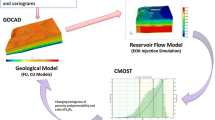Abstract
A newly developed, multistage quick-look methodology allows for the efficient screening of an unmanageably large number of reservoirs to generate a workable set of sites that closely match the requirements for optimal CO2 enhanced oil recovery (EOR) storage. The objective of the study is to quickly identify miscible CO2 EOR candidates in areas that contain thousands of reservoirs and to estimate additional oil recovery and sequestration capacities of selected top options through dimensionless modeling and reservoir characterization. Quick-look assessments indicate that the CO2 EOR resource potential along the US Gulf Coast is 4.7 billion barrels, and CO2 sequestration capacity is 2.6 billion metric tons. In the first stage, oil reservoirs are screened and ranked in terms of technical and practical feasibility for miscible CO2 EOR. The second stage provides quick estimates of CO2 EOR potential and sequestration capacities. In the third stage, a dimensionless group model is applied to a selected set of sites to improve the estimates of oil recovery and storage potential using appropriate inputs for rock and fluid properties, disregarding reservoir architecture and sweep design. The fourth stage validates and refines the results by simulating flow in a model that describes the internal architecture and fluid distribution in the reservoir. The stated approach both saves time and allows more resources to be applied to the best candidate sites.









Similar content being viewed by others
References
Cracoana AN (1982) Enhanced oil recovery in Rumania. Society of Petroleum Engineers, SPE, Enhanced oil recovery symposium, Paper No. 10699, Tulsa, 4–7 April
Carbon sequestration technology roadmap and outreach plan, 2006 (2006) US Department of Energy, National Energy Technology Laboratory, April 2006
Diaz D, Bassiouni Z, Kimbrell W, Wolcott J (1996) Screening criteria for application of carbon dioxide miscible displacement in waterflooded reservoirs containing light oil. Paper SPE 35431 presented at the 1996 SPE improved oil recovery symposium, Tulsa, April 21–24
Galloway WE, Ewing TE, Garrett CM, Tyler N, Bebout DG (1983) Atlas of major Texas oil reservoirs. The University of Texas at Austin, Bureau of Economic Geology, special publication, p 139 + plates
Ham J (1996) Ranking of Texas reservoirs for application of carbon dioxide miscible displacement. Science Applications International Corporation, April 1996
Holm LW, Josendal VA (1982) Effect of oil composition on miscible-type displacement by carbon dioxide. Society of Petroleum Engineers, pp 87–98
Holtz MH, Nance, Peter, Finley, Robert J (2001) Reduction of greenhouse gas emissions through underground CO2 sequestration in Texas oil reservoirs. American Association of Petroleum Geologists Environmental Geoscience Journal, September, p 187–199
Interstate Oil and Gas Compact Commission (1993) An evaluation of known remaining oil resources in the State of Texas. Project on advanced oil recovery and the states. Project report, Vol. III, November 1993
Jarrell PM, Fox CE, Stein MH, Webb SL (2002) Practical aspects of CO2 flooding. SPE Monographs, vol 22, p 220
Korose C, Garner D, Luther A, Frailey S, Seyler B (1994) Oil field screening study for CO2 sequestration and enhanced oil recovery in the Illinois basin. DOE-NETL-funded study, contract report DE-FC26–03NT41994
Kosters EC, Garrett CM, Banta N, White WG (1991) Atlas of major Texas gas reservoirs. The University of Texas at Austin, Bureau of Economic Geology, special publication
Kovscek AR (2002) Screening criteria for CO2 storage in oil reservoirs. Petrol Sci Technol 20:842–866 Nos. 7, 8
Mungan N (1981) Carbon dioxide flooding fundamentals. J Can Petrol Technol January–March:87
Rivas O, Embid S, Bolivar F (1992) Ranking reservoirs for CO2 flooding processes. Paper SPE 23641, SPE Latin American Petroleum Engineering conference, Caracas, March 1992
Stalkup FI Jr (1984) Miscible displacement. SPE of AIME, Monograph, vol 8
Standing MB (1947) A pressure–volume–temperature correlation for mixtures of California oil and gases. Drill and Prod Prac API, pp 275–287
Taber JJ, Martin FD, Seright RS (1997) EOR screening criteria revisited. Part 1: Introduction to screening criteria and enhanced oil recovery field projects, SPE 35385
Wood DJ, Lake LW, Johns R, Nunez V (2006) A screening model for CO2 flooding and storage in Gulf Coast reservoirs based on dimensionless groups, SPE 100021
Acknowledgments
The Gulf Coast Carbon Center, Bureau of Economic Geology acknowledges support of this research by BP America, Chevron, NRG, Entergy, KinderMorgan, Marathon, Schlumberger, Praxair and the John A. and Katherine G. Jackson School of Geosciences. Publication was authorized by the Director, Bureau of Economic Geology.
Author information
Authors and Affiliations
Corresponding author
Rights and permissions
About this article
Cite this article
Núñez-López, V., Holtz, M.H., Wood, D.J. et al. Quick-look assessments to identify optimal CO2 EOR storage sites. Environ Geol 54, 1695–1706 (2008). https://doi.org/10.1007/s00254-007-0944-y
Received:
Accepted:
Published:
Issue Date:
DOI: https://doi.org/10.1007/s00254-007-0944-y




